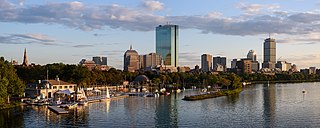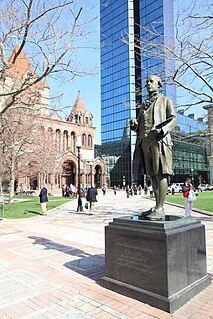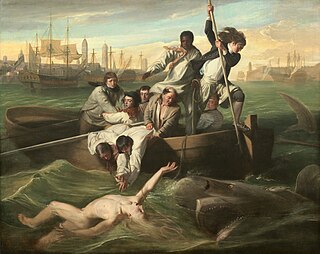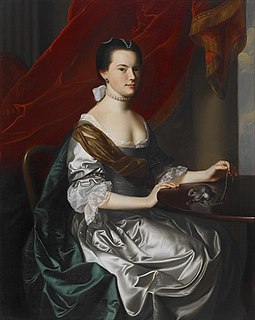
John Singleton Copley was an Anglo-American painter, active in both colonial America and England. He was probably born in Boston, Massachusetts, to Richard and Mary Singleton Copley, both Anglo-Irish. After becoming well-established as a portrait painter of the wealthy in colonial New England, he moved to London in 1774, never returning to America. In London, he met considerable success as a portraitist for the next two decades, and also painted a number of large history paintings, which were innovative in their readiness to depict modern subjects and modern dress. His later years were less successful, and he died heavily in debt.

Back Bay is an officially recognized neighborhood of Boston, Massachusetts, built on reclaimed land in the Charles River basin. Construction began in 1859, as the demand for luxury housing exceeded the availability in the city at the time, and the area was fully built by around 1900. It is most famous for its rows of Victorian brownstone homes—considered one of the best preserved examples of 19th-century urban design in the United States—as well as numerous architecturally significant individual buildings, and cultural institutions such as the Boston Public Library, and Boston Architectural College. Initially conceived as a residential-only area, commercial buildings were permitted from around 1890, and Back Bay now features many office buildings, including the John Hancock Tower, Boston's tallest skyscraper. It is also considered a fashionable shopping destination and home to several major hotels.

The Prudential Center is an enclosed shopping mall within the mixed-use Prudential Center complex in the Back Bay neighborhood of Boston, Massachusetts. It is located at the base of the Prudential Tower, and provides direct indoor connections to several nearby destinations including the Hynes Convention Center, the office towers at 101 and 111 Huntington Avenue, and the Sheraton Boston hotel. The mall is connected to the Copley Place shopping mall via a skybridge over Huntington Avenue. As of 2022, the complex currently features a Saks Fifth Avenue, and notable brands such as Earl's, Lacoste, Club Monaco, Ralph Lauren, and Vineyard Vines.

The Fairmont Copley Plaza is a Forbes four-star, AAA four-diamond hotel in downtown Boston, Massachusetts managed by Fairmont Hotels and Resorts. It stands on Copley Square, part of an architectural ensemble that includes the John Hancock Tower, Henry Hobson Richardson's Trinity Church, and Charles Follen McKim's Boston Public Library.

Copley Square, named for painter John Singleton Copley, is a public square in Boston's Back Bay neighborhood, bounded by Boylston Street, Clarendon Street, St. James Avenue, and Dartmouth Street. Prior to 1883 it was known as Art Square due to its many cultural institutions, some of which remain today. It was proposed as a Boston Landmark.

The Museum of Fine Arts is an art museum in Boston, Massachusetts. It is the 20th-largest art museum in the world, measured by public gallery area. It contains 8,161 paintings and more than 450,000 works of art, making it one of the most comprehensive collections in the Americas. With more than 1.2 million visitors a year, it is the 52nd–most visited art museum in the world as of 2019.

Huntington Avenue is a secondary thoroughfare in the city of Boston, Massachusetts, beginning at Copley Square, and continuing west through the Back Bay, Fenway, Longwood, and Mission Hill neighborhoods. Huntington Avenue is signed as Route 9. A section of Huntington Avenue has been officially designated the Avenue of the Arts by the city of Boston.

Watson and the Shark is an oil painting by the American painter John Singleton Copley, depicting the rescue of the English boy Brook Watson from a shark attack in Havana, Cuba. Copley, then living in London, painted three versions. The 1778 version is in the National Gallery of Art, Washington, D.C. A second, full-size 1778 replica is now in the Museum of Fine Arts, Boston, and a third, smaller, 1782 version with a more vertical composition, is in the Detroit Institute of Arts.

Louisburg Square is a private square located in the Beacon Hill neighborhood of Boston, Massachusetts that is maintained by the Louisburg Square Proprietors. While the Proprietors pay taxes to the City of Boston, the city does not own the square or its garden. It was named for the 1745 Battle of Louisbourg, in which Massachusetts militiamen led by William Pepperrell, who was made the first American baronet for his role, sacked the French Fortress of Louisbourg. Louisburg Square has become one of the most exclusive neighborhoods in the US, with townhouses listing for over $15,000,000.

The Defeat of the Floating Batteries at Gibraltar is the title of a 1791 oil-on-canvas painting by Boston-born American artist John Singleton Copley. It depicts the defeat of the floating batteries at Gibraltar during the Great Siege of Gibraltar. The Governor of Gibraltar, General George Augustus Eliott, is on horseback pointing to the rescue of the defeated Spanish sailors by the British.

Peter Pelham, an American portrait painter and engraver, born in England, a son of a man named "gentleman" in his will. His father, who died in Chichester, Sussex, in 1756, is revealed in letters to his son in America as a man of some property.

Henry Pelham was an American painter, engraver, and cartographer active during the late 18th century. Pelham's many illuminating letters, especially to his half-brother John Singleton Copley, provide an important contemporary perspective of the events of the American Revolution.

The Copley Society of art is America's oldest non-profit art association. It was founded in 1879 by the first graduating class of the School of the Museum of Fine Arts and continues to play an important role in promoting its member artists and the visual arts in Boston. The Society is named after the renowned John Singleton Copley. The gallery currently represents over 400 living artist members, ranging in experience from students to nationally recognized artists and in style from traditional and academic realists to contemporary and abstract painters, photographers, sculptors, and printmakers. Several of the artists working in the tradition of the Boston School of painters exhibit at the Copley Society of Art, along with the Guild Of Boston Artists a few doors down from the Copley Society of Art's Newbury Street location.

The Death of Major Peirson, 6 January 1781 is a 1783 large oil painting by John Singleton Copley. It depicts the death of Major Francis Peirson at the Battle of Jersey on 6 January 1781.

Katharine Greene Amory was an 18th-century Bostonian known for the journal she kept during the American Revolution. It is valued by historians for its record of daily life and for its window onto the viewpoint of a Loyalist woman.

Mrs. Theodore Atkinson Jr. is a portrait painting by John Singleton Copley. Copley completed the painting in 1765. The painting is now housed in the Crystal Bridges Museum of American Art.
A statue of Joseph Warren is installed in a lodge adjacent to the Bunker Hill Monument in Charlestown, Boston, in the U.S. state of Massachusetts.

A statue of Phillips Brooks is installed outside the Trinity Church in Boston's Copley Square, in the U.S. state of Massachusetts.

The Columbus Monument is a monument by the sculptor Alois G. Buyens depicting Christopher Columbus, commissioned by members of the Boston-area Catholic community in 1892. It is one of the first statues that the Belgian-born Buyens created after coming to America in 1892 and opening a studio in Boston. The monument was to be installed at La Isabella to mark the site of the first Catholic Church in the Americas. A copy of the monument was installed in Boston. The Boston version was moved several times, and it is now located in front of the Saint Anthony of Padua Church in Revere, Massachusetts.

A Boy with a Flying Squirrel , or Henry Pelham , is a 1765 painting by the American-born painter John Singleton Copley. It depicts Copley's half-brother Henry Pelham with a pet flying squirrel, a creature commonly found in colonial American portraits as a symbol of the sitter's refinement. Painted while Copley was a Boston-based portraitist aspiring to be recognized by his European contemporaries, the work was brought to London for a 1766 exhibition. There, it was met with overall praise from artists like Joshua Reynolds, who nonetheless criticized Copley's minuteness. Later historians and critics assessed the painting as a pivotal work in both Copley's career and the history of American art. The work was featured in exhibitions at the Museum of Fine Arts, Boston, and the National Gallery of Art. As of 2021, it is held by the former.



















